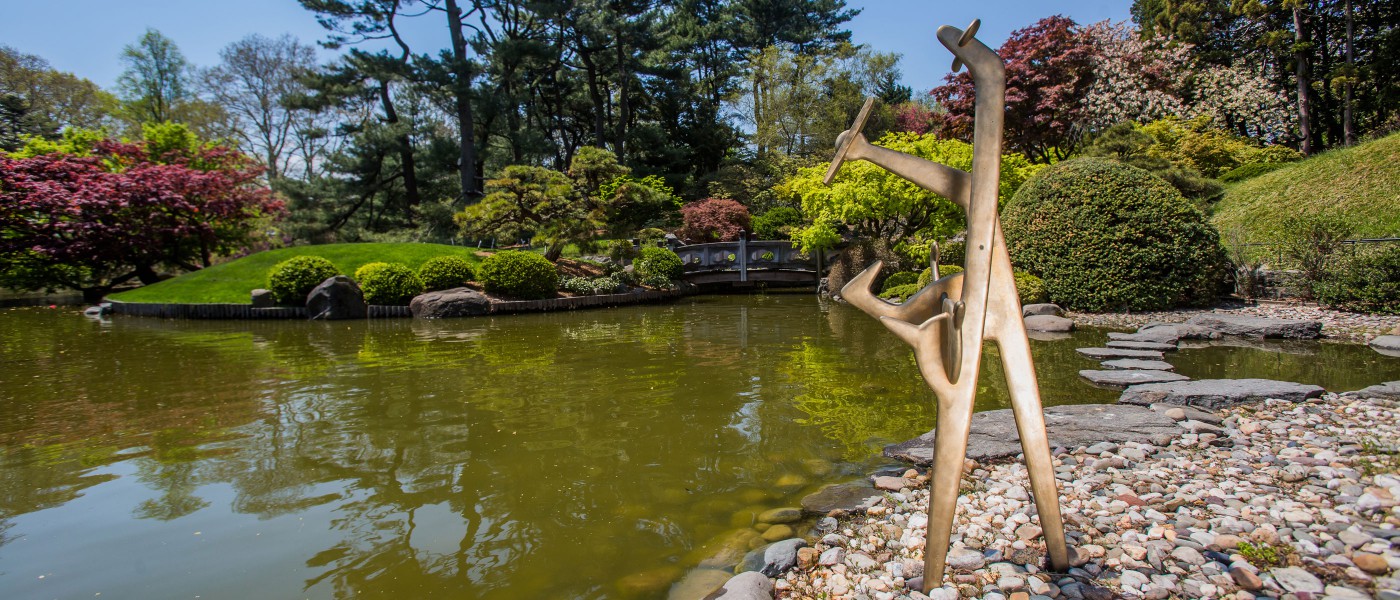In collaboration with The Noguchi Museum, Brooklyn Botanic Garden is pleased to present a Garden-wide installation of sculptures by the renowned Japanese-American artist Isamu Noguchi. Curated by the Museum's senior curator Dakin Hart, the show features 18 works from the Museum's permanent collection that have been specifically chosen for various settings at BBG. The centerpiece of the installation is a selection of seven works in the Japanese Hill-and-Pond Garden that interact subtly with the setting’s rolling hills, rocks, pond, and plantings.
Download Exhibition Brochure and Map (PDF)
Visit the Conservatory Gallery to see Isamu Noguchi: The Transformation of Nature, a selection of rare photographs from The Noguchi Museum’s archives relating to Noguchi’s vision of public spaces and his work as a garden, park, and playground designer.
Guided Tours
Saturdays | 11 a.m., Sundays | 2 p.m.
Stroll with a trained Garden Guide to view this extraordinary exhibition of Noguchi sculptures, placed amid the Garden’s living collections.
Tuesdays | 2 p.m.
Learn more about the artist and his work on a walk guided by educators from The Noguchi Museum.
Tuesday–Sunday | 1 p.m.
Fall Seasonal Highlights tour featuring Noguchi’s works
All tours meet at Magnolia Plaza by the building steps.
Audio Tour
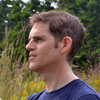
Introduction
See the exhibit through the eyes of its curator, Dakin Hart of The Noguchi Museum, and learn more about the works on display.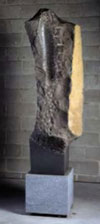
Age
1981, basalt
Location: Elm Grove (southeast of Bluebell Wood)Isamu Noguchi on Age:
“A gift comes from the past, the residue of what we have already done. The unwanted part. Then one day there is revealed to us another potential which we are now ready for. To find from our own past the needed confidence: out of violence comes a calm.”
Beginnings
1985, andesite
Location: outside the Rock Garden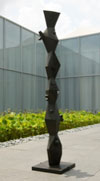
Bird Song
1952 (cast 1985), bronze
Location: Cherry Esplanade
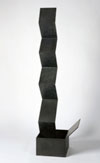
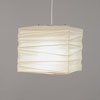
Jack in the Box
1984, bronze plate
Akari 33X
Paper, bamboo, metal
Location: Japanese Hill-and-Pond Garden, viewing pavilionIsamu Noguchi on Jack-in-the-Box and Akari:
"The quality of Akari is very much related to the materials of its origin: washi, the handmade paper from the inner bark of the mulberry trees, so superb for the purpose of transmitting light, and higo, the bamboo ribbing, which can be bent and shaped in numerous ways. For me, function was only an initial consideration; my main purpose has always been art as it related to life. I work with the gamut of possibilities. Inherent in Akari are lightness and fragility. They seem to offer a magical unfolding away from the material world."
"Jack-in-the-Box is based on the principles of a toy that comes from antiquity. Folding paper is called origami in Japan."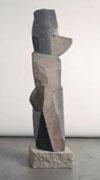
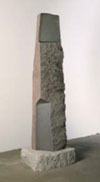
Kyoko-san
Isamu Noguchi on Kyoko-san and Personage I (Ningen I):
1984, andesite
Personage I (Ningen I)
1984, andesite
Location: Japanese Hill-and-Pond Garden, south shore of pond
"Kyoko-san was finished in the fall of 1984 in time for my 80th birthday on November 17, at which time an exhibition and a celebration were held at the Sogetsu Kaikan in Tokyo. The wonder of stone is that through its working, the possibilities are discovered. As the artist delves ever deeper, perception reveals itself and finally leads his hand to its secret understanding."
"It is not that the stone is so perfect in itself. Imperfection is itself a help in guiding the artist, not perfection. But obviously there must be something in the stone, a predisposition that permits the artist to imagine, and something in the sequence of its cutting that has a rationale which reveals the sculpture in all its economy. Personage I is close to the essential sculpture I strive for."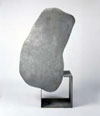
Magritte's Stone
1982–83, hot-dipped galvanized steel
Location: Osborne GardenIsamu Noguchi on Magritte's Stone:
"[This sculpture with hot-dipped galvanizing is] from a group of 26 that were made in collaboration with Gemini G.E.L. in Los Angeles. The idea of multiple sculptures available to many with a limited budget appealed to me. These sculptures were thus made to help support the museum."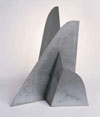
Mountains Forming
1982–83; hot-dipped galvanized steel
Location: Japanese Hill-and-Pond Garden, hill above the waterfall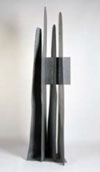
Rain Mountain
1982–83, hot-dipped galvanized steel
Location: Japanese Hill-and-Pond Garden, outside west gateIsamu Noguchi on Rain Mountain:
"The spirit, Chinese mountains seen in mist, as shadow, as setting for a distant trip—the different moods of nature were in my thoughts."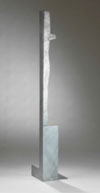
Root and Stem
1982–83; hot-dipped galvanized steel
Location: Desert Pavilion
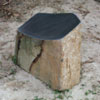
Sky Mirror
1970, basalt
Location: Japanese Hill-and-Pond Garden, north side of pondIsamu Noguchi on Sky Mirror:
"Each sculpture is a miracle of chance. The shape, the size, the color, the blemish, its correction. And time, which completes all things, brings the sun into its alignment, when stone becomes mirror."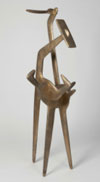
Strange Bird
1945 (cast 1971), bronze, gold patina
Location: Japanese Hill-and-Pond Garden, Turtle IslandIsamu Noguchi on Strange Bird:
"In 1972, Arne Ekstrom suggested that a show be held of many replicas of the same sculpture. Strange Bird was selected for this clever demonstration. There were six bronzes cast and two reproductions in aluminum...along with the original one of green slate."
This Earth, This Passage
1962 (cast 1963), bronze
Location: Native Flora Garden, council circleIsamu Noguchi on This Earth, This Passage:
"I began this piece by working with wet clay on the floor of a studio in Rome in the summer, using my bare feet, just as I used to do kneading clay for firing ceramic in 1931 in Kyoto."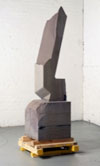
Untitled
1986, basalt
Location: Native Flora Garden, upper circle

The Whole
1984, granite
Location: Osborne Garden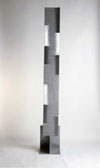
Wind Catcher
1982–83, hot-dipped galvanized steel
Location: Ginkgo AlléeIsamu Noguchi on Wind Catcher:
"Wind Catcher...was actually worked out in the final metal while determining how the individual elements could be bent to the desired curve. Always there is this linkage of structure to sculpture. The bend that curves for volume in appearance as well as for structural strength."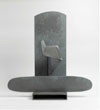
Zazen
1982–83, hot-dipped galvanized steel
Location: Bonsai House
All Noguchi quotes are from The Isamu Noguchi Garden Museum.
Isamu Noguchi
The Japanese-American artist Isamu Noguchi (1904–88) was one of the most untrammeled creative forces of the 20th century: a biracial, multiculturally sophisticated, categorization-defying, maverick polymath determined to follow in the footsteps of those he considered America’s true artists—Benjamin Franklin, Alexander Graham Bell, Thomas Edison, and Henry Ford. But as a sculptor. Noguchi had a particular talent for connecting with other brilliant people and was among the first Americans to consider himself, and to behave like, a citizen of the world.
Over a career spanning eight decades, Noguchi created sculptures that populate some of the world’s greatest museums and important civic spaces from New York, Los Angeles, and Mexico City to Tokyo, Jerusalem, Paris, and many other places in between. He designed a case for the world’s first baby monitor, the largest stainless steel relief ever made, the fountain at the center of Ford Motor Company’s 1939–40 “World of Tomorrow” World’s Fair pavilion, playground equipment, the most recognizable coffee table of the 20th century, and Akari, a line of Japanese-style lamps still going strong after 60 years. He never met a new material he didn’t like, but he loved clay and stone.
Between 1933 and 1965, Noguchi proposed five different designs for playgrounds in New York City—none of them, thanks in large part to Robert Moses’ rigid Parks Department, realized. Among his many collaborations with other artists, architects, and designers was his 60-year relationship with choreographer Martha Graham, for whom he created 19 set designs, most of which are still in use. The centerpiece of his 1986 Venice Biennale exhibition for the American Pavilion, entitled What is Sculpture? was a usable, 60,000-pound white marble slide. Noguchi also founded what is still the only museum in the United States designed by an artist to show his own work.
Learn More
Pick up the artist’s autobiography, Isamu Noguchi: A Sculptor’s World, or Hayden Herrera’s recently published biography of the artist, Listening to Stone: The Art and Life of Isamu Noguchi. For more information about Noguchi and his work, visit noguchi.org.
Curator's Statement
There is a botanical analogy for Isamu Noguchi’s temporary appearance at BBG: the volunteer plant, which, though placed by an outside force (in this case a curator) rather than planted by a gardener, is often welcome. Migratory birds and glacial erratic boulders, also at home at BBG and referenced in the Noguchi works perched, sprouted, and deposited throughout the Garden, are other, equally appropriate zoological and geological analogies. Each sculpture in the exhibition is meant, in other words, to appear to have materialized through some extraordinary natural process, but it has actually been sited to connect with the Garden’s rich traditions of scientific inquiry and aesthetic display.
As a connoisseur of public spaces all over the world, Noguchi would have been very pleased to have his work in one of the oldest and most important botanic gardens in the United States. He once described The Noguchi Museum as an oasis on the edge of a black hole (meaning Manhattan). Brooklyn Botanic Garden, this magnificent 52-acre microcosm of Earth, is another. Throughout his career, Noguchi sought to move beyond what he called "the false horizon of the museum pedestal." Earth, with everything on it—mobile and fixed, ephemeral and timeless, natural and man-made—was his idea of the perfect sculpture. He wanted users of the spaces he created to experience them, he said, as man first discovered the planet—much as generations of New Yorkers have fallen in love with Earth and its boundless wonders here at BBG.
Our seemingly innate tendency to seek meaning both in the structure of the atom and in the expansion of the universe, in the micro and the macro alike, as we learn to do in miniature universes like a botanical garden or a great work of art, is encapsulated in the famous opening lines of a poem Noguchi knew well, William Blake’s “Auguries of Innocence”:
To see a World in a Grain of Sand
And a Heaven in a Wild Flower
Hold Infinity in the palm of your hand
And Eternity in an hour…
Noguchi’s determination to harness the sublimity of nature on both a cosmic and molecular scale was greatly enhanced by his friendship with the utopian futurist and engineer, Buckminster Fuller, who coined the term “Spaceship Earth.” It was with Fuller’s unfailingly mind-bending encouragement, reinforcing his natural inclination, that Noguchi developed the ability to invest his work—objects and environments—with a sense of their place in time and space on multiple, simultaneous layers of scale and meaning. The intent of Isamu Noguchi at Brooklyn Botanic Garden is to explore this resonance between what Noguchi called nature’s “infinite reserve,” the serenity and lack of obvious exertion to be found even in her most awesome exercises of power, and his own attempts to create deep and lively universal mysteries.
Noguchi once suggested that any sculpture sited outdoors could be judged by the same standard a gardener would use to evaluate the placement of a stone or a tree: Does it enhance the whole—that is, does it improve the environment in which you’ve planted it? You will have to judge whether we have succeeded in temporarily augmenting this Garden and whether Noguchi’s sculptures, as sited here, merit temporary classification with the rocks and the trees.
—Dakin Hart, Senior Curator, The Noguchi Museum
Visit The Noguchi Museum
On the occasion of its 30th anniversary, The Noguchi Museum presents Museum of Stones (October 7, 2015, to January 10, 2016). This major exhibition looks at the ways in which artists have explored the intersection of rock and culture in tools, structures, myths, language, and systems of abstract thought as man has strived to understand and manage our world. The exhibition features the work of 30 contemporary artists, as well as a selection of 16 rock-related masterpieces of Chinese art from the Metropolitan Museum of Art. Learn more at noguchi.org.


